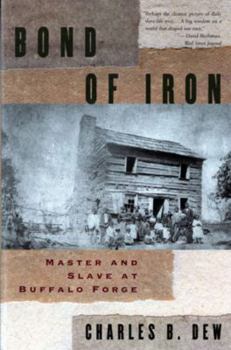Bond of Iron: Master and Slave at Buffalo Forge (Revised)
Select Format
Select Condition 
Book Overview
At Buffalo Forge, an extensive ironmaking and farming enterprise in Virginia before the Civil War, a unique treasury of materials yields an "engrossing, often surprising record of everyday life on an estate in the antebellum South" (Kirkus Reviews).
Format:Paperback
Language:English
ISBN:039331359X
ISBN13:9780393313598
Release Date:September 1995
Publisher:W. W. Norton & Company
Length:448 Pages
Weight:1.45 lbs.
Dimensions:1.2" x 6.1" x 9.2"
Customer Reviews
2 ratings
Dew's book proffers at least a greater insight, if not direct answers, to significant questions abou
Published by Thriftbooks.com User , 17 years ago
Charles B. Dew describes the relationship between master and slave in a manufacturing setting. His 1994 book Bond of Iron, Master and Slave at Buffalo Forge, as the title suggests, is the story of industrial slavery but in a plantation setting. Under a pragmatic master, slave ironworkers, because of their special skills, were able to exert a degree control over their lives. Specialized knowledge, so essential for the operation, effectively gave them a measure of power over their master. Dew's thesis is that coercion had its limits in the setting of industrial slavery at Buffalo Forge and that slave laborers were able to use the system to affect a degree of control over their own lives. Dividing his book into three parts, Dew writes first about the master William Weaver, a Pennsylvanian investor. Contrary to his antislavery Dunker and northern origins, Weaver embraced slavery in his adopted home in western Virginia to become an enduring and wealthy iron master. Even though he came from an antislavery family and was a realistic self-seeking master, his real feelings about slavery are known by what he in fact did: he owned, used, and profited from slaves. Without resorting to physical violence, Weaver nonetheless maintained control by selling slaves who proved recalcitrant. Daniel Brady, his nephew, succeeded William Weaver when he died in 1863. Dew next describes the lives of six of Weaver's more skilled slaves and how they were able to use the task and overwork system to improve their lot in life. The task and overwork system was an incentive and reward system for certain skilled slaves. Weaver credited them for work completed over and above a certain minimum. One of these slaves, Sam Williams, even had his own savings account. Sam, one of Weaver's master refiners, was able to earn extra money for production above his weekly task and had it deposited in a local bank. Another was Henry Towles a skilled forge man. Another, Tooler, used the system to his advantage and, once his quota was met, would do over-work only as he saw fit. His skill as the "best chaffery forgeman William Weaver had" (197) gave him a degree of control over his life. Harry Hunt, Jr. was one of the most versatile slaves filling in for other slaves as necessary. Henry Mathews, another capable slave, could do work at the forge or on the plantation with equal aplomb. He was "the ultimate jack-of-all-trades." (204) Dew reconstructs the Garland Thomson family history through forge records and present-day descendants. It is a story of "pride and the image of strength." (211) In the third part Dew discusses the effects of the Civil War on Buffalo Forge and how the bond between master and slave evolved after emancipation. The forge was uncompetitive in the new economic order and soon was forced to close down. Former slaves, unable to afford land of their own, turned to sharecropping to eke out a living on the plantation or dispersed. Dew uses a large body of records fortuitous
Read this important Book!
Published by Thriftbooks.com User , 25 years ago
This is a new, different telling of an old story. It really challenges what many have come to believe about slavery and the relationship between master and servant. Highlights the distinction between skilled and unskilled labor that is at the core of so many social problems (race, sex, class), yet is so often overlooked.





